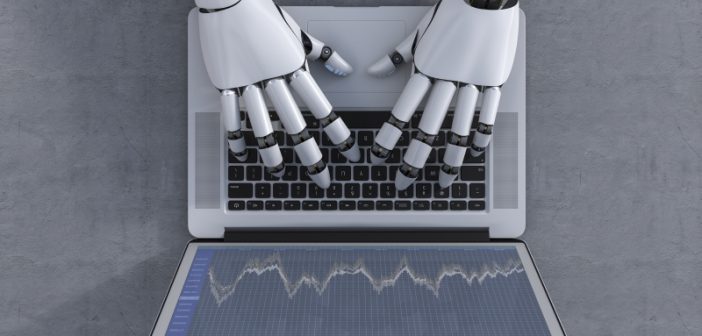
Machine learning is very much the ‘topic of the moment’. It is being discussed everywhere, whether as machine learning, or as artificial intelligence. Machine learning techniques and tools have been around for a while, however, so why now? Is it just an idea whose time has come, or have there genuinely been new developments that have made a difference?
Two important developments
I think the answer is probably a bit of both. Machine learning was a bit of a niche market until recently. What has changed is two things. First is the increase in the volume of data — which makes it hard, if not impossible, to process by hand, or using simpler computational techniques. It also, however, makes it possible to train machine learning algorithms, because enough data is now available.
The second change is the potential computing power available. When you think back to the rooms that used to house computer servers, and the fact that we now have as much, if not more, computing power available in an individual smartphone, the exponential growth in power becomes clear. This power is also cheap. This makes a huge difference.
These two developments are important. But you also need a recognition that machine learning can help. More and more organisations are recognising the value of data-driven insights into behaviour, trends, and forecasts, and how they can improve the bottom line. Machine learning and artificial intelligence algorithms offer more powerful ways to get good insights. In that sense, therefore, it is an idea whose time has come.
Developing use cases
As a result of the rapid uptake of machine learning techniques, the number of use cases is also rapidly developing. This, in turn, spreads the information that machine learning may be able to help, creating a virtuous cycle of learning. Rapidly growing areas of developing include fraud detection and resolution, and techniques like image recognition used in motor insurance claims processing.
There are, however, far more examples of use cases than many people would even imagine. Machine learning techniques feature in automatic translation software (remember the ‘rate this translation’ button in Facebook? It feeds back to the algorithm, helping it learn). They are part of search engine technology, stock management, planned maintenance, claims handling, and even simple customer care processes via chatbots. These systems are all using AI and machine learning technology to improve efficiency, and provide a better service to customers.
The sheer ubiquity of these systems and techniques suggests that most organisations are already likely to be using at least one. Which brings us back to the question of why machine learning is now such a hot topic. I think that the biggest issues are scale and visibility. What is changing is that uses are becoming more obvious: from search engines (where the use of algorithms is largely invisible to the uninitiated) to chatbots (where they are very, very public), for example.
The use of real-time analytics, too, makes a difference. Being able to analyze behaviour in real time and act directly to prevent fraud, or to improve customer service, makes a big difference to value. This takes AI from the realms of the retrospective into the prospective: from analyzing past actions to predicting (and managing) future performance. The speed of the processing — far beyond human capability — is one of the real powers of AI, and enables organisations to move faster from data to value. Automation has been key to achieving this.
Whether you are a data scientist, business sponsor or IT facilitator, the coming AI-driven transformation demands you keep pace with possibilities. Join fellow innovators at Analytics Experience, and learn from a mix of thought leadership driven discussions, concrete case studies and hands-on workshops.
Governance, ethics and partnership
This sounds like machine learning is outrunning human intelligence, but that is not really the case. There are things that machines and algorithms can do much better, such as rapid processing of huge amounts of data, and developing decisions about patterns and meaning. But there are also things that humans can do better, such as ethics, emotions and understanding.
Governance and ethics are vital to the ongoing development and use of machine learning techniques. Visibility is, and will remain, crucial. And by visibility, I mean transparency—being able to explain how decisions are made, and being confident that they are fair. Rapid deployment of models means that they are more accurate, because all data has a sell-by date. But models also need to be retired, redeveloped and retrained. This kind of governance needs people.
This partnership between people and algorithms will only become more important as organisations scale up their use of machine learning models, and models become more a part of ‘how we do business’.
Sign up to this webinar series and learn about the practicalities of artificial intelligence and making AI business-smart.
Take a few minutes to explore more on machine learning.


1 Comment
We are the students of BI Muhammad Sherjeel Khan, Muhammad Aamir.
This Topic is useful information in BI from deep learning and Machine learning is Big Data with the increase in the volume of data which makes it hard, if not impossible, to process by hand, or using simpler computational techniques.
Technology with Google, Facebook, Twitter Big Volume of Big Data and the field of data analytics, machine learning is a method used to devise complex models and algorithms that lend themselves to prediction; in commercial use, this is known as predictive analytics. These analytical models allow researchers, data scientists, engineers, and analysts to "produce reliable, repeatable decisions and results" and uncover "hidden insights" through learning from historical relationships and trends in the data. It is helpful in BI and Thanks Again